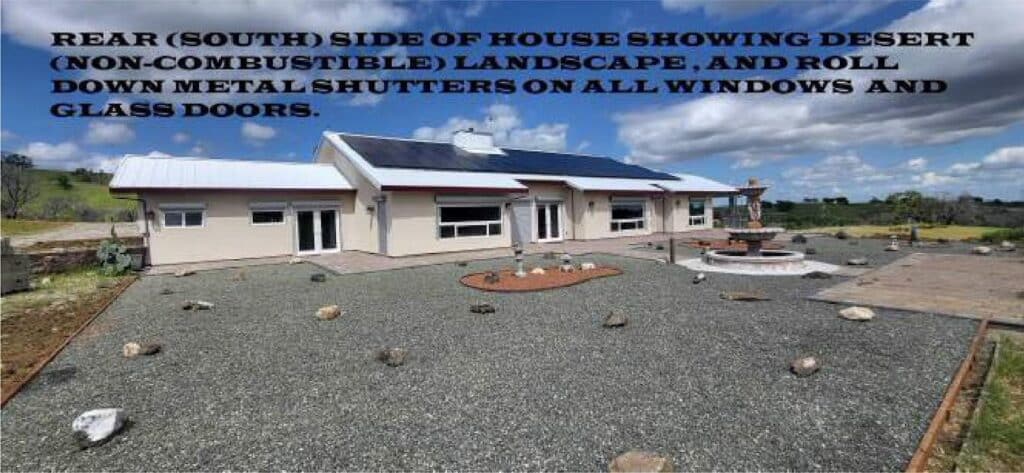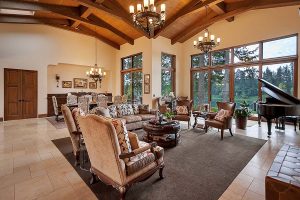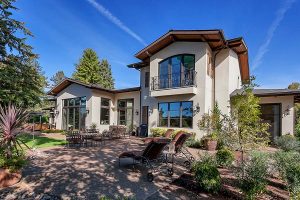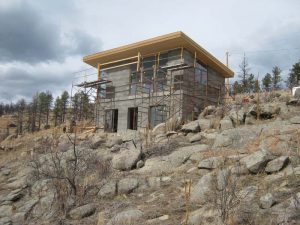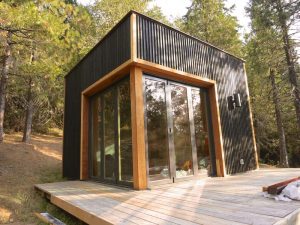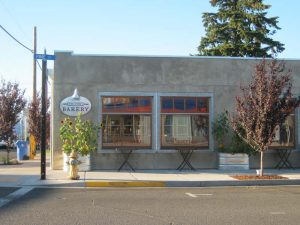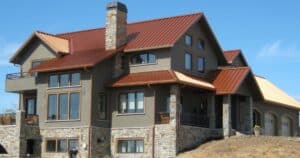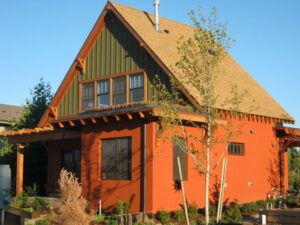Wildfires are an increasing threat in regions prone to dry conditions and extreme heat. In areas like California, where wildfires are a significant risk, it’s crucial to take proactive steps to protect homes and loved ones from these devastating disasters. For one homeowner, the experience of losing a dream home to a wildfire underscored just how important it is to build with fire-resistant materials and plan carefully for maximum safety.
This article explores how to protect your home from wildfires, focusing on the importance of fire-resistant house design and fire-resistant home construction. It also covers the best materials to use and explains why Faswall blocks are an excellent choice for creating a sustainable, fire-resistant house.
Losing a Home to a Wildfire
In 2012, a couple built their dream home on 25 acres in California, fully aware that they were in a Wildland Urban Interface (WUI) zone. They took every precaution to ensure their home was fire-resistant, following and exceeding every published fire safety guideline. The home was equipped with fire-rated shingles, fire-resistant doors and windows, and fire-safe landscaping. They even installed a 5,000-gallon water storage tank and ensured the driveway was wide and accessible to fire trucks, following recommendations from Cal Fire to clear 100 feet of defensible space around the property.
Their efforts were substantial: they used non-combustible materials like stucco for exterior finishes and concrete-based products for roofing and siding. They also ensured that the home’s roof overhangs and soffits were designed to be as fire-resistant as possible. A regular fire inspection by Cal Fire crews praised the house’s fire preparedness. The crews even commented that if every homeowner maintained their property to the same standards, firefighters would be out of a job. The couple was confident in their preparations, believing their home was as safe as it could be.
But in August of 2020, disaster struck. The couple’s home, along with everything they owned, was consumed by the wind-driven LNU Lightning Complex Fire, which ravaged parts of California. The fire came with incredible intensity, fanned by extreme winds that were so fierce they burned through tree trunks at ground level while leaving the leaves and branches untouched. Despite their meticulous preparation and the fire safety features of the home, there was little they could do when faced with the ferocity of the wildfire.
As the fire encroached from all directions, the couple evacuated their home, watching helplessly as the flames engulfed their dream home. The fire had spread so quickly that no fire trucks were able to reach the property, even though the Fire Command Post was set up just 100 feet away.
When the fire finally passed, the couple found that the only parts of their home left standing were the masonry chimney, concrete slab foundation, and stem walls—all made from non-combustible materials. This made them realize just how critical it was to use fire-resistant construction materials. The fire had not only damaged their property but had highlighted the fact that even the best fire-prepared homes could be vulnerable.
Faced with this devastating loss, the couple had to make a difficult decision. Should they sell the land and relocate, or should they rebuild in the most fire-resistant way possible? Given that wildfires are a growing concern across the western U.S., and even urban areas aren’t exempt from the threat (i.e. the Los Angeles Fires this year), they ultimately decided to rebuild. The couple was drawn back to the land for its views, proximity to family and friends, and the unique charm of the area. However, the rebuilding process came with many challenges, including material shortages, rising costs, and delays caused by the ongoing COVID-19 pandemic.
Rebuilding: Choosing Fire-Resistant Materials for Long-Term Safety
Rebuilding after a wildfire is an emotionally and physically demanding process. However, this couple was determined to ensure their new home would be as fire-resistant as possible, not just for their safety, but for the longevity of the property. Their goal was to design a home that would withstand even the most extreme conditions that wildfires could throw at it.
The rebuilding process was challenging. They encountered material shortages, labor delays, and rising costs due to supply chain issues stemming from the COVID-19 pandemic. The couple even ended up working alongside hired contractors to complete much of the work themselves. Their experience was a combination of perseverance, resourcefulness, and a deep understanding of the importance of fire-resistant construction.
One of the first major decisions they made was to use Faswall blocks for the majority of the home’s walls. Faswall blocks are an innovative building material made from 85% recycled wood chips and 15% concrete. These blocks have a remarkable 4-hour fire rating, meaning they can withstand flames and high heat for up to four hours. Faswall blocks also offer excellent insulation, keeping the home cooler in the summer and warmer in the winter, while reducing energy costs and carbon emissions.
In addition to Faswall blocks, the couple opted for a combination of other fire-resistant materials throughout the rebuild:
- Concrete floors and steel framing replaced the traditional wood framing that was used in their original home. Concrete floors provide both insulation and fire resistance.
- Stucco was chosen as the exterior finish for its non-combustible properties. This choice, along with the Faswall walls, ensured that the structure would be highly resistant to the intense heat of wildfires.
- The roof was rebuilt with standing seam metal, a fire-resistant roofing material that can withstand the high heat of a wildfire. The roof also featured an XFR fire-resistant underlayment to further protect against fire.
- Roll-down metal shutters were installed over all windows and glass doors to protect them from radiant heat, embers, and potential fire penetration.
- A fire sprinkler system was incorporated into the design, as well as a roof sprinkler system to reduce the risk of the fire spreading to the home.
In addition to these fire-resistant measures, the couple incorporated passive solar design elements to reduce energy consumption. The house was built with south-facing windows to capture solar heat during winter, while overhangs were designed to prevent excessive heat gain in the summer. The couple also added solar panels with a battery backup system to minimize reliance on the grid, making the home more sustainable and self-sufficient.
One of the most important decisions the couple made was to eliminate any combustible materials. There were no wood floor joists or subfloors, no plywood, no hardwood flooring, and no wall-to-wall carpeting. Instead, they used concrete for the floor with foam insulation beneath it, tile flooring, and 5/8-inch fire-rated gypsum board for the interior walls. These non-combustible materials greatly reduced the potential for fire damage to spread inside the home.
For the exterior, the couple carefully planned firebreaks around the property. They used gravel to maintain clear, defensible space, which could be easily managed with a small tractor mower. They also designed the landscape with cactus and boulders to create a fire-resistant garden that required little maintenance and minimized the risk of wildfire spread.
The Importance of Fire-Resistant House Design
Rebuilding a home in a wildfire-prone area requires more than just following basic fire safety guidelines. Fire-resistant house design involves a comprehensive approach that addresses every part of the structure, from the foundation to the roof. It’s about selecting the right materials and making strategic design choices that will minimize the risk of fire damage.
After the devastating loss, the couple chose to rebuild their home with a focus on fire-resistant home construction. They used a combination of non-combustible materials, sustainable features, and cutting-edge construction techniques to make their home nearly fireproof. This included avoiding traditional wood elements and opting instead for Faswall blocks, which offer superior fire resistance and sustainability.
What Materials Are Fire-Resistant?
Knowing what materials are fire-resistant is critical when designing a home in a wildfire-prone area. The best materials will not only protect the structure from flames but will also help prevent the spread of fire. Some of the most effective materials for building a fire-resistant home include:
- Faswall Blocks
Faswall blocks are an ideal fire-resistant material for building a home in wildfire-prone areas. Made from 85% recycled wood chips and 15% concrete, these blocks have a 4-hour fire rating and are highly resistant to high heat. Faswall blocks also offer excellent insulation properties, keeping the home comfortable in both hot and cold climates while reducing energy costs. They are lightweight, easy to handle, and environmentally friendly, making them a top choice for building sustainable, fire-resistant homes. - Concrete and Masonry
Concrete is naturally fire-resistant, making it an excellent choice for foundations, walls, and even roofing. Masonry materials like brick and stone are similarly resistant to fire and provide lasting protection. - Steel Framing
Steel framing is a popular choice for fire-resistant home construction because it won’t burn, warp, or collapse under high heat. Unlike wood, steel provides a solid and safe structure that can withstand extreme conditions. - Stucco and Other Non-Combustible Exterior Finishes
Stucco is a non-combustible material that serves as a durable and protective exterior finish. It is commonly used in homes in wildfire zones for its ability to resist heat and prevent flames from penetrating the structure. - Fire-Resistant Roofing Materials
Roofs made from metal, clay tiles, or slate are highly resistant to fire. In the rebuild, a standing seam metal roof was chosen for its ability to withstand extreme heat and its low maintenance requirements. - Fire-Resistant Glass and Doors
Fire-rated glass and fire-resistant doors are designed to resist the intense heat of a wildfire and prevent flames from entering the home. This is especially important for homes with large windows or expansive glass doors.
Faswall Blocks: The Best Material to Build a Fire-Proof Home
One of the standout materials the couple used in their rebuild is Faswall blocks. These blocks are made from 85% recycled wood chips and 15% concrete, making them an eco-friendly and highly effective building material. The manufacturing process removes the cellulose from the wood chips and replaces it with silica, giving the blocks their impressive fire resistance. Faswall blocks are tested to have a 4-hour fire rating, the highest rating achievable in fire tests.
Faswall blocks are not only fire-resistant, but they also provide excellent insulation, keeping the house cool in summer and warm in winter. Unlike traditional concrete blocks, which are heavy and have a higher carbon footprint due to their production process, Faswall blocks are much lighter, easier to handle, and more environmentally friendly. By using these blocks, the couple was able to create a fire-resistant home construction that minimized the risk of fire damage while also reducing the overall environmental impact.
The combination of Faswall blocks with other non-combustible materials, such as stucco and steel, resulted in a home that was significantly more resilient to wildfires than their previous one.
Building a Fire-Resistant Home for Long-Term Safety and Sustainability
The experience of losing a home to a wildfire can be devastating, but it also highlights the critical importance of fire-resistant house design and fire-resistant home construction. By selecting the right materials, such as Faswall blocks, homeowners can significantly reduce the risk of fire damage while building a more sustainable, eco-friendly home. Faswall blocks, with their 4-hour fire rating and lightweight fire-resistant properties, are one of the best materials available for creating a fire-resistant home that stands the test of time.
For homeowners in wildfire-prone areas, taking the necessary steps to make their homes as fire-resistant as possible can be the difference between safety and destruction. Whether building a new home or rebuilding after a fire, investing in the right materials is essential for long-term protection. This couple’s story is a testament to the importance of making thoughtful, proactive decisions to safeguard their home—and their future—against the growing threat of wildfires.
Ready to protect your home from wildfires? Consider the benefits of building with Faswall blocks and other fire-resistant materials for your next construction or renovation project. Don’t wait for disaster to strike—take action now to safeguard your property, your loved ones, and your future. Reach out to a knowledgeable contractor or fire safety expert today to learn more about fire-resistant building materials, building with Faswall, and how you can incorporate them into your home. Start building for safety and sustainability now!

